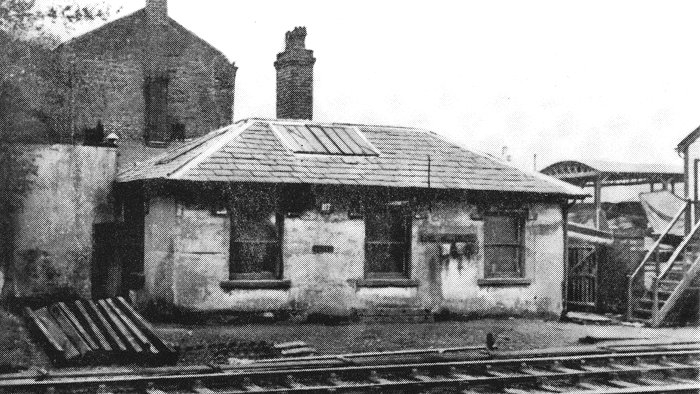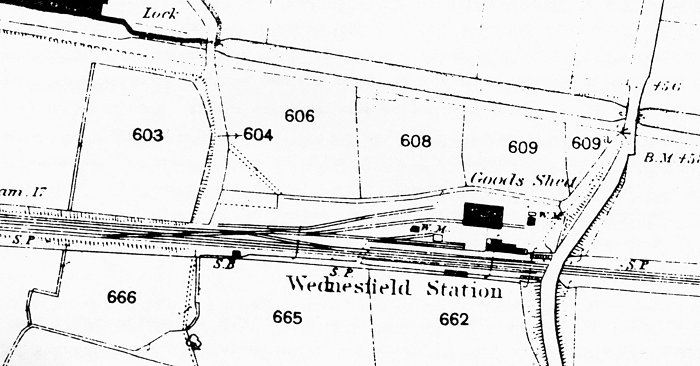Wolverhampton's First
Station
|

The derelict station as it appeared in
1951. Courtesy of Wolverhampton Reference Library. |
|
On July 4th one hundred and fifty years ago,
Wolverhampton's first station opened for business with the
arrival of the locomotive "Wildfire" and its train. The Grand
Junction connected the city of Birmingham with the Liverpool and
Manchester Railway from a junction at Warrington, a distance of
eighty miles. The London and Birmingham Railway, linking
Birmingham with the capital, was under construction.
The station for Wolverhampton was at
Wednesfield Heath, one and a quarter miles from the town centre.
At this time Wednesfield Heath was a small rural community,
though it was to expand rapidly, changing its name in the
process to Heath Town. Entitled "Wolverhampton", despite its
distance from the town centre, the small bungalow-like building
was designated as a "first-class" station, the first along the
line from Birmingham, the next such station being at Stafford,
fifteen miles along the line. Between Stafford and Wolverhampton
were four intermediate "second class" stations.
The station was described in "Osborne’s
Guide to the Grand Junction Railway" of 1838:
Wolverhampton, the sixth station (from
Birmingham) of the second class trains and the first station of
the first class trains….. Here all engines stop, both in going
and returning, to be supplied with water and coke and to have
the engine examined, and the wheels greased. As this is a
station of some importance, there are always omnibuses and cars
ready to take passengers to the town. At every station there is
a neat and commodious office for the reception of passengers,
and the transaction of business, and at all principal stations
there is a private room for females…. The station is being made
into a commercial depot. The Company are building spacious and
commodious warehouses, and an engine-house capable of holding
two or three engines.....hitherto, the line of road has been but
sparingly employed by the Wolverhampton merchants, for want of a
warehouse to deposit goods; and whenever an additional engine
has been required at this end of the line, it has been obliged
to be fetched from Birmingham.
The station was a small stuccoed building
and stood on the highest point of the original main-line at 440
feet above sea level. The approach from Birmingham came via a
tunnel 186 yards in length and 25 feet wide. On emerging from
the bore, the trains passed through a cutting for 300 yards to
arrive at the station building.
These must have seamed quite grandiose to
the early rail travellers, rushing along at hitherto unheard of
speeds. The station master was a man called Broadbent, who lived
in a cottage in Neachells Lane. His wife died in the cholera
epidemic of 1849, after bearing him three children, Job, Will,
and Helen. The opening of the rai1way initially was resisted by
many local concerns. The traders of Wolverhampton and Walsall
being aligned with the canal interests. There were no official
opening celebrations at all at Wolverhampton, though constables
had been positioned along the line in case of riot. At Stafford
in contrast, the first train was greeted by a cannon salute. |

The station is seen on the left here, with
the goods buildings behind. On the right is the station master's
house. Courtesy of Wolverhampton Reference Library. |
|
The benefits of railway communication, once
established, soon changed local opinions, and a clamouring went
up for a closer connection with the town centre. The station at
Wednesfield Heath was never popular. This was not due only to
its distance from the town. No rival station appeared until
1849, but local businessmen found good reason to avoid the Grand
Junction route long before alternative railway connections were
established. Whilst the Grand Junction retained its monopoly on
local rail services, it could do it seemed, very much as it
pleased, and complaints of service, goods and passenger rail
charges, were very numerous. As prices went up, the number of
trains decreased, to the extent that coach and canal services
were able to retain some sort of competition, against the normal
odds.
The Grand Junction persisted in running a disproportionate
number of "first" only trains, second class passengers having to
wait for an interim service. By 1844 the second class fare from
Wolverhampton to Birmingham was raised from 2s to 2s 6d, the
local newspaper noting that the canal packets, coaches and
omnibuses charged 1s 6d for the same journey. The complaints
went on unheeded, from the potteries to Liverpool, in "universal
condemnation of this powerful company” and the seeds were sown
for the advance of rival approaches into the Black Country.
In 1852 the L.N.W.R. as successor to the
G.J.R., opened a station in the town centre at Queen Street.
Another north-south route saw the opening of the O.W.W./G.W.R.
joint station below the Queen Street station in 1854. The
usefulness of the small station at Wednesfield Heath was
finished. In May 1853 expresses ceased to call there, passengers
from Birmingham for Wolverhampton changing at the newly opened
station at Bushbury Junction whilst the Stour Valley line to
Birmingham was completed. The station at Wednesfield closed in
September 1853, to re-open in August 1855 as ''Wednesfield
Heath", having been signposted as ''Wednesfield Heath for
Wolverhampton" for some time prior to its closing. The approach
to the station was unhealthy even by the standards of the day,
potential passengers being warned in the Wolverhampton Chronicle
that the footpath between the station and the town was lined
with:
....a stinking accumulation of filth and
sewerage… ....and now, to make matters worse, a heap of night
soil (waste from open toilets) is exhibited in one of the
fields, which is so disgusting that I advise your readers not to
pass, especially if the sun is at all powerful.
In January 1873 the section of the line
between Willenhall Bridge and Bushbury Junction was closed, the
intermediate stations at Portobello and Wednesfield closing with
it. The line was re-opened in 1881, but the stations were not.
Until their demolition in the 1960s however both the old station
and its goods shed were still to be seen, being in private
commercial use. |

Wednesfield station as it appeared on the 1885
Ordnance Survey map. Courtesy of Ordnance Survey and
Wolverhampton Reference Library. |
References
Osbourne's Guide to the Grand Junction Railway. 1838.
The Railways of Great Britain and Ireland. Francis Whitshaw.
1840.
The Railway Magazine. July 1952.
Railways of the West Midlands 1808 -1954. Stephenson Locomotive
Society.
Family history as related by Mr. A. J. Summerfield.
Wolverhampton Chronicle, as stated in the text. |
 |
|
 |
|
 |
| Return to
Driver Jones |
|
Return to
the Beginning |
|
Proceed to
The Kings |
|